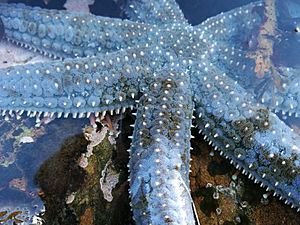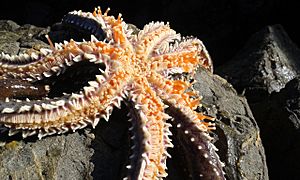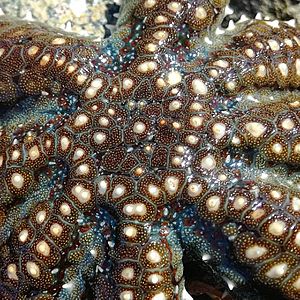Seven-armed starfish facts for kids
Quick facts for kids Seven-armed starfish |
|
|---|---|
 |
|
| Astrostole scabra | |
| Scientific classification | |
| Kingdom: | |
| Phylum: | |
| Class: | |
| Order: |
Forcipulatida
|
| Family: |
Asteriidae
|
| Genus: |
Astrostole
|
| Species: |
A. scabra
|
| Binomial name | |
| Astrostole scabra Hutton, 1872
|
|
The Astrostole scabra, also known as the seven-armed starfish, is a type of sea star. It belongs to the family Asteriidae. You can find this sea star living in New Zealand, eastern Australia, and southern Australia.
This starfish often lives in rocky areas near the ocean, like tide pools. It can also be seen attached to dock poles. It is one of the biggest sea stars found in New Zealand. Adult starfish like to eat mussels. They use their strong tube feet to pull open the mussel shells. They can hold the shells open for a long time.
What Does It Look Like?
The seven-armed starfish can grow quite large. Some can be up to 35 centimeters (about 14 inches) across! Their colors can be orange, dark red, or brown. Some are light blue or grey.
The top side of the starfish has bumpy plates. From the center of these plates, one or two short, white spines stick out. These spines are special bone-like pieces called ossicles. The spines are usually blunt on top. They can be sharper and longer on the sides of the arms. Young starfish might have blue spines.
The starfish has many tube feet on its underside. These feet are a mix of off-white and bright orange. A special spot called the madreporite, which helps it take in water, is hard to see.
Starfish that live in tide pools are usually smaller. They have thicker plates on their skin. This helps protect them when waves crash over them. Even with this protection, they can still get more damaged than starfish living in deeper water.
Where Does It Live?
The seven-armed starfish is common on rocky reefs and rocky shores. Adult starfish have been found in water as deep as 150 meters (about 490 feet).
A. scabra does not have a permanent home. It moves around a lot. So, starfish found in one area might have just moved there randomly. Younger starfish are more adventurous than adults. They move around a lot in tide pools and shallow coastal areas. They usually stay in water less than 20 meters (about 65 feet) deep.
Reproduction
This starfish becomes ready to reproduce when its internal skeleton (ossicles) gets thinner. At the same time, its arms grow to at least 110 millimeters (about 4.3 inches) long. A. scabra can reproduce in two ways: sexually and asexually. Asexual reproduction means it can sometimes split itself to make new starfish.
Things in the environment, like water temperature, help the starfish make eggs and sperm. When they reproduce, their young spread out. This happens through tiny larvae floating in the water. They can drift between the surface and 100 meters deep. This way, the young starfish move away from where they were born. This helps reduce competition for food and space in one area. Spawning usually happens in late August and early September. This is when there is a lot of plankton in the water for the larvae to eat.
What Does It Eat?
The size of an A. scabra starfish affects what it eats. Bigger starfish tend to eat bigger prey. One study found that a group of these starfish ate species from 60 different groups of animals!
Smaller starfish, with arms 10-29 millimeters long, eat most often. They are especially active in May and June. Starfish with arms 50-89 millimeters long eat more steadily throughout the year. Not only do small starfish eat more often, but they also eat bigger portions for their size.
As the starfish grow, their diet changes. When they are small (arms 10-19mm), tiny snails called rissoids and eatoniellids make up almost half of their food. Other snails called trochids and chitons are only a small part of their diet.
However, for starfish with arms 30-39mm long, rissoids and eatoniellids are a very small part of their diet. Chitons, on the other hand, become a much bigger part. Rissoids and eatoniellids are not a main food source for starfish with arms 29mm-89mm long. They are not eaten at all by starfish with arms longer than 89mm. Chitons and trochids stay in the diet until the starfish's arms are longer than 159mm.
As the starfish get bigger, they eat more spiral-shelled snails and chitons. These types of prey would be too big for a small starfish to eat. This change in diet is very important for the starfish to survive and live a long time. It means that starfish of different sizes don't compete much for the same food. This might be a big reason why this starfish is so successful in its environment.



